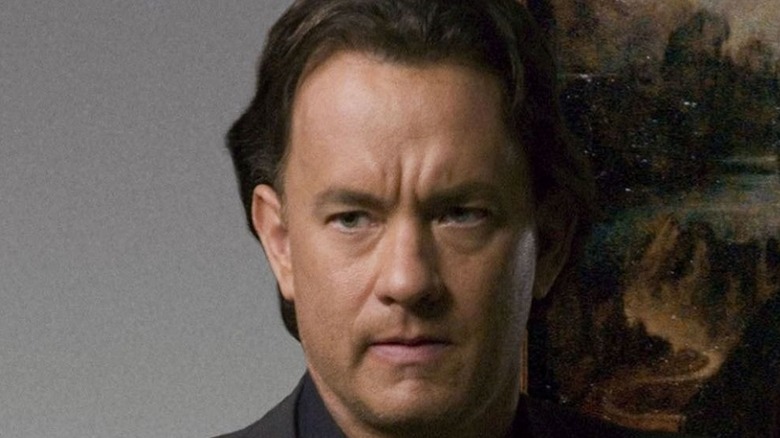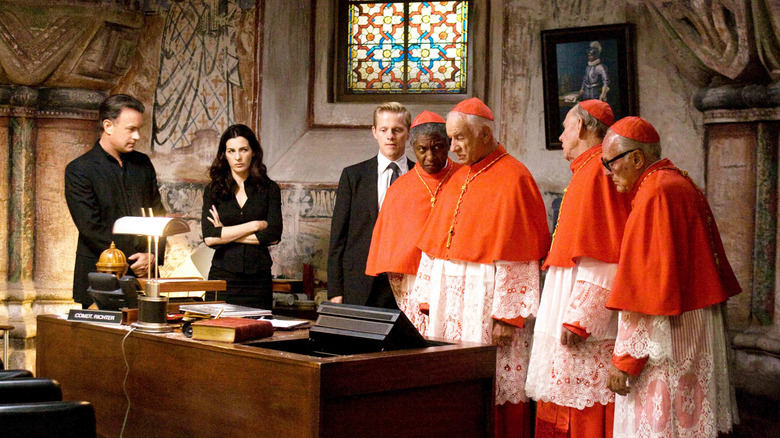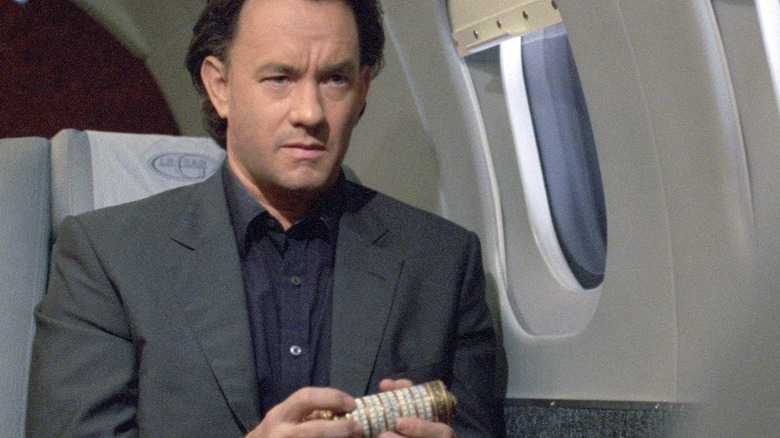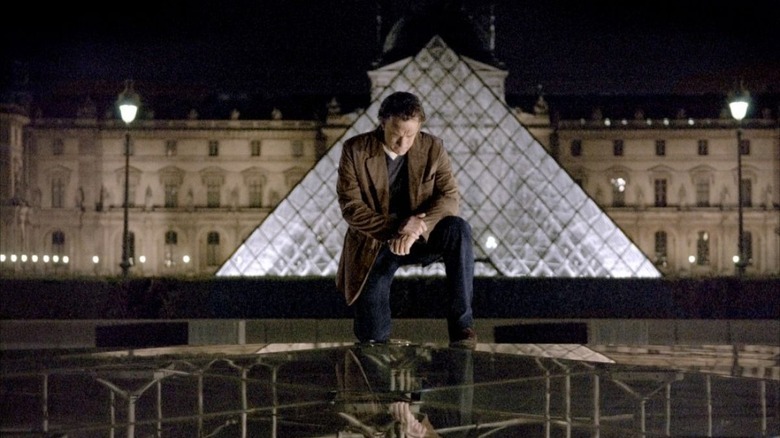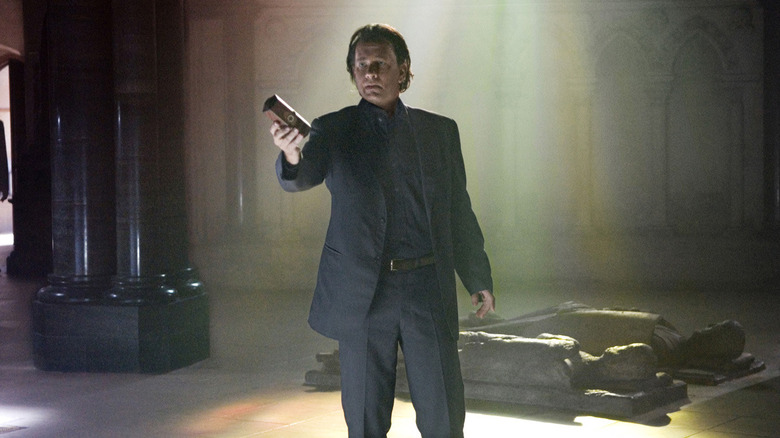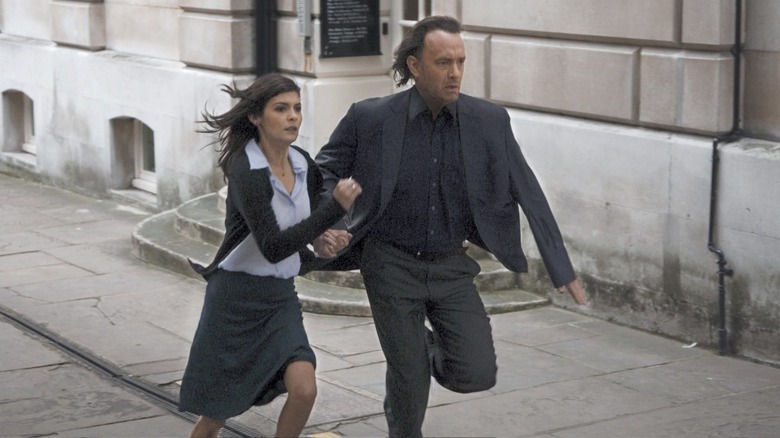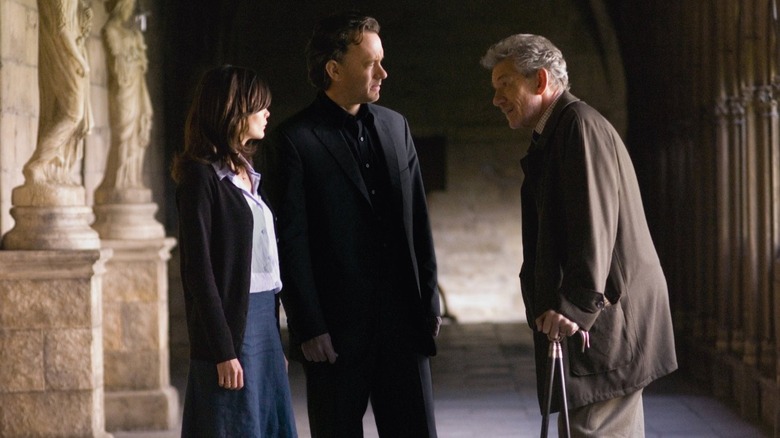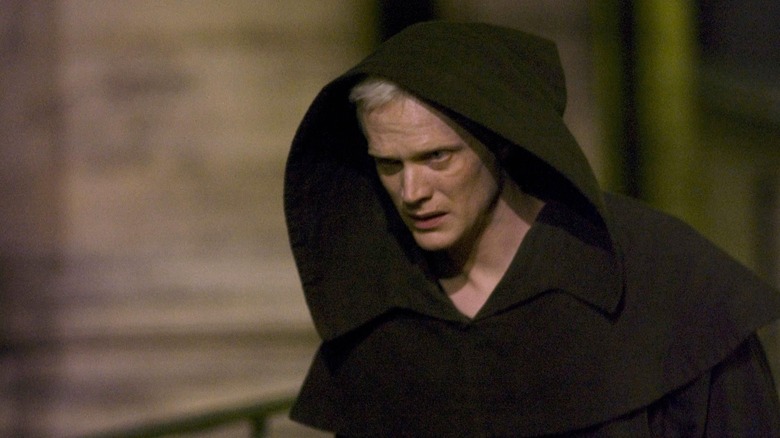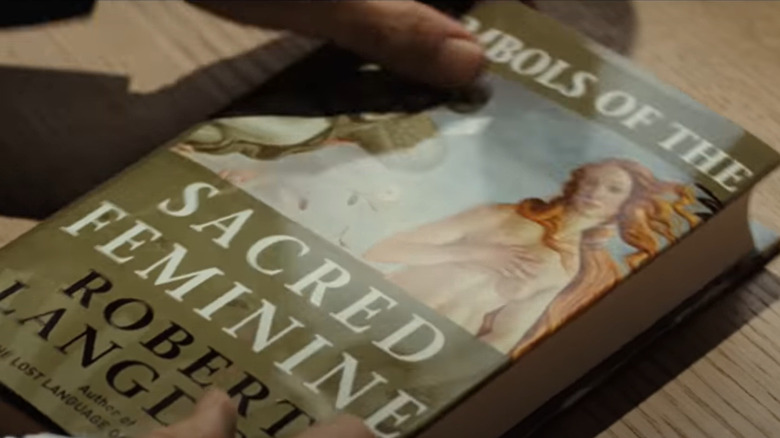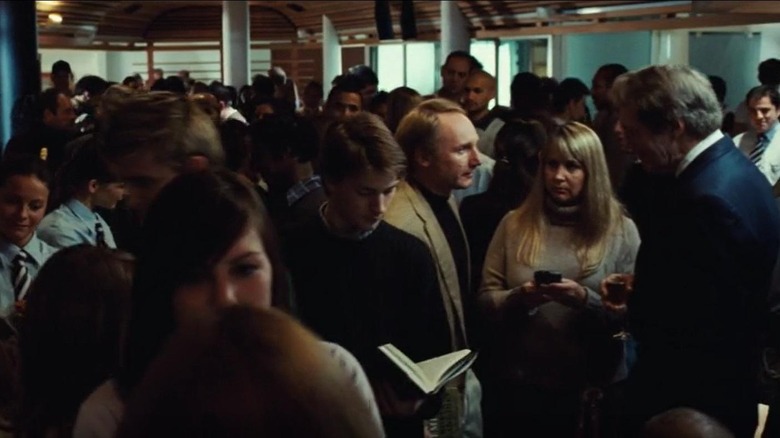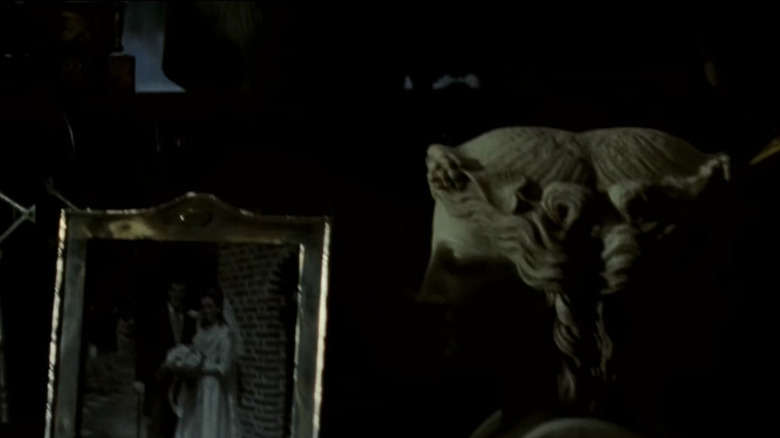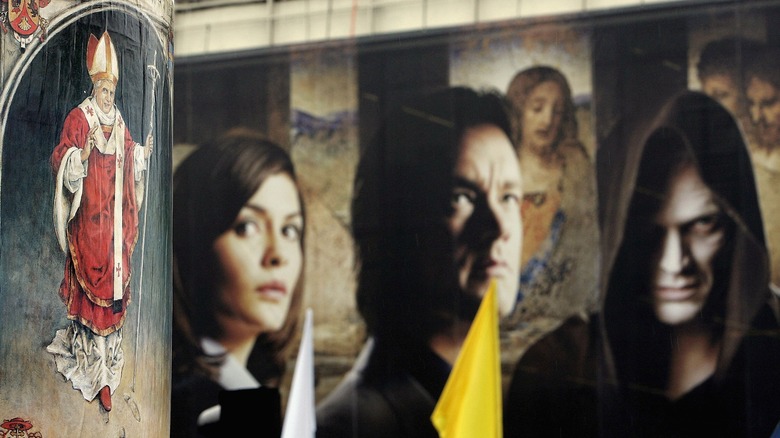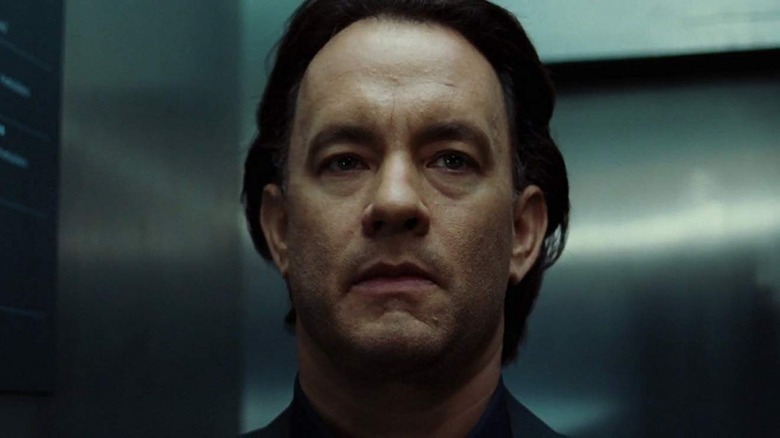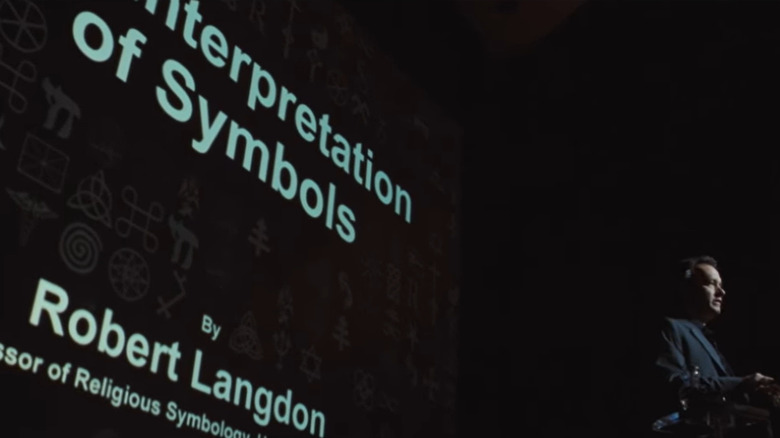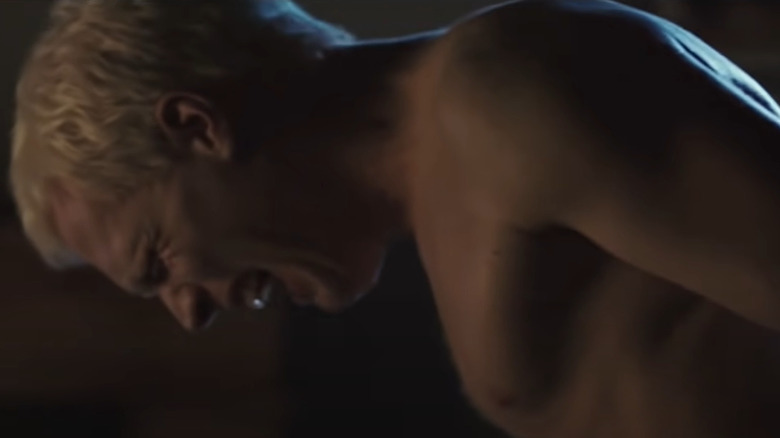The Untold Truth Of The Da Vinci Code
Author Dan Brown's 2003 novel "The Da Vinci Code" was a publishing phenomenon unlike any other at the time of its release. Despite garnering criticism for it's Christianity-themed conspiracy mythology, the book become a chart-topping bestseller all over the world. Naturally, Hollywood soon came calling for the book's adaptation rights.
In 2006 director Ron Howard released the movie version of "The Da Vinci Code" starring Tom Hanks in the lead role as Robert Langdon, a dashing professor of symbology. Following the death of a renowned museum curator, Langdon is brought in as a potential suspect. He soon finds himself caught up in a web of deep intrigue surrounding a world-changing mystery that powerful organizations are bent on keeping secret. Meanwhile a deadly assassin is on Langdon's trail as well as the police and local authorities.
A fast-paced thriller that mixes history, mythology, action, and conspiracy theories, "The Da Vinci Code" was a huge success at the box office (via Box Office Mojo). This prompted the studio to make further adaptions of other "Robert Langdon" novels by Dan Brown, with Hanks reprising his role as the adventurous professor in the hit franchise. Here are some facts about "The Da Vinci Code" film that fans need to know.
The film does not follow the timeline of the novels
While "The Da Vinci Code" was the first novel about Robert Langdon to achieve breakout success, it is actually the second novel in the series written by Dan Brown. The first one is 2000's "Angels and Demons," which sees Langdon caught up in a criminal conspiracy surrounding the Vatican Church and its new pope.
Hollywood studios were less interested in keeping to the timeline established by the novels and more focused on minting the outsized popularity of "The Da Vinci Code." Thus its movie adaptation was conceived as a standalone feature, and any references to Langdon's previous adventure in the Vatican found in the novel were scrubbed from the film. One example is the fact that Langdon is considered a minor celebrity in "The Da Vinci Code" book despite only being a university professor due to his involvement in the events of "Angels and Demons."
It helps that Robert Langdon's adventures across multiple novels rarely connect in a significant manner. Langdon is the only recurring character in the series, and the events of one novel rarely make any impact on others. This has allowed the makers of the "Robert Langdon" movies to pick and choose which installments to adapt into films without having to worry about continuity in the way the Marvel Cinematic Universe has to.
Hanks likes playing 'the smartest guy in the room'
Tom Hanks made his career out of playing simple, everyday men in standalone dramas and comedies. In fact, his best-known role in "Forrest Gump" had Hanks portraying a guy who is far from the sharpest tool in the shed. This is in direct contrast to Hanks' role as Robert Langdon, a Harvard professor and minor athlete.
In "The Da Vinci Code," the story starts because Langdon is brought in during a murder investigation as an expert in his field (and secretly a suspect). The plot continues thanks to Langdon's astute observations and ability to decipher riddles and codes that had stumped the police and other authorities. This makes Langdon's character a bit like Sherlock Holmes, and someone that Hanks enjoyed playing because of his standout intelligence (per Reuters).
"You give me the right amount of verbiage and just enough time to do the right amount of research, and I can convince you that I may be the smartest guy in the room," Hanks joked while promoting "Inferno," the second sequel to "The Da Vinci Code" that saw Hanks returning in the role of Langdon with the fate of civilization once again at stake.
Shooting at the actual Louvre
One reason "The Da Vinci Code" feels like a more prestigious movie than run-of-the-mill conspiracy films is because it takes place at many fancy real-world locations that do not normally allow movies to shoot on their premises. But when you have Tom Hanks and filmmaker Ron Howard attached to the project, doors tend to open invitingly.
Case in point, the Louvre, possibly the most swanky museum in the world. "The Da Vinci Code" starts with a murder at the Louvre that has baffled the police. Instead of recreating the museum on a Hollywood stage, the makers of the film decided to go straight to the source. The caretakers of the museum agreed to allow filming on the premises, provided strict precautions were taken during the process. "It was complicated," admitted Henri Loyrette, the president-director of the Louvre, to The New York Times. "It involved enormous preparation. But things worked out very well."
The film crew was only allowed to shoot at night. None of the artwork could be touched or directly illuminated. Blood or any kind of marking was not allowed to deface the floors, and even food and drink could not be brought into the museum for the crew. According to Ron Howard, the various restrictions actually ended up working in their favor, since the low lighting added to the mysterious ambience of the film's opening scene.
Swapping out the Abbey for a Cathedral
While the caretakers of the Louvre proved unexpectedly cool about playing along for the sake of shooting "The Da Vinci Code" at the real-life location, other location-holders the makers of the movie reached out to were not so accommodating. This had the greatest impact on the scene in the book that takes place at Westminster Abbey in the United Kingdom.
When the caretakers of the Abbey were asked for their permission to allow filming for the film, the request was shut down in no uncertain manner. "'The Da Vinci code' is theologically unsound," declared a statement issued by the Abbey according to The Guardian. "We cannot commend or endorse the contentious and wayward religious and historic suggestions made in the book."
This refusal turned out to be a blessing for the Lincoln Cathedral, which became a stand-in for the Abbey for the required scenes in "The Da Vinci Code." As detailed by the Dean's Verger, John Campbell, the hype created by the edifice showing up in the movie led to a 22% increase in visitors and a corresponding boost in donations apart from the hefty fee paid by the film producers to shoot at the location (via BBC). The money helped keep the Lincoln Cathedral running and assisted with continuous restoration work being carried out at there.
Friends in high places
For the current generation, it can be difficult to imagine the hysteria surrounding the release of "The Da Vinci Code" novel by Dan Brown. It garnered intense controversy due to its subject matter, and rocketed to the top of bestseller lists and news stories in a way not seen since the hype surrounding the "Harry Potter" novels.
When it was announced that "The Da Vinci Code" would be getting a Hollywood adaptation with Ron Howard and Tom Hanks attached, the excitement reached a fever pitch. Even former French president Jacques Chirac had a personal and extended meeting with the producers in which he assured them of his support for filming in France.
On top of that, according to a report by Newsweek (via The Guardian), Chirac allegedly even suggested a role for his daughter's friend as the heroine Sophie Neveu. The controversy surrounding the incident was such that Chirac's office had to issue a statement categorically denying that he had tried to influence the casting decision for the movie in any manner.
Digging into the backstory for Sir Leigh Teabing
One of the most prominent characters in "The Da Vinci Code" is Sir Leigh Teabing, a wealthy acquaintance of Robert Langdon who shares his interest in religious history. After being forced to go on the run from the police, Langdon approaches Teabing for help and together the duo sets about deciphering the ancient mystery at the heart of the movie.
While Teabing is a very dynamic character who moves the plot forward even more than Langdon, readers do not know a lot about his backstory in the novel save for the fact that he suffered from a disease at some point that left him unable to walk without the help of crutches and leg braces. Sir Ian McKellen was cast in the role of Teabing, and the veteran actor decided that he needed to personally add some detail to the character's history before diving in.
"Dan Brown doesn't get into all that," McKellen explained to The Associated Press (via Today). "You [personally concoct a backstory] just to convince yourself and reference it throughout in the performance." Among the details the actor worked out was that Teabing suffered from low self-esteem, and he made up for it by obsessing over his studies about the Holy Grail. This eventually turned into a sort of mania after the death of his wife when Teabing was left alone without any children or family to distract him from his thoughts.
The scene that broke Tom Hanks
Tom Hanks is generally acknowledged to be one of the best actors in Hollywood, a thorough professional who rarely breaks character in a scene and always brings his A game. He is also considered one of the nicest people in Hollywood who gets along with everyone. Both these qualities were sorely tested in Hanks' big fight scene opposite Paul Bettany in "The Da Vinci Code."
Bettany plays the role of Silas in the movie, a psychotic monk tasked by a secret society to kill Robert Langdon before he can uncover the truth about the Holy Grail. Throughout the movie Silas comes close to personally executing Langdon a few times. One such scene required Hanks and Bettany to get into a physical brawl that ended up taking more of a toll on Hanks' body than he had anticipated.
"I had to grab him and I had to punch him in the stomach and it's very quiet on set," Bettany told Stephen Colbert in an interview. "So, everybody's listening, and I punched him in the stomach and he farted really, really, really loudly." To make matters even more awkward, while Bettany and the rest of the crew tried to decide how to react to Hanks letting one rip, the actor chose to underline the moment even further by saying to Bettany, "What is wrong with you? You just made me fart!"
Refences to character backstories
"The Da Vinci Code" is all about major events hiding in plain sight. The film claims that the answer to the mystery of the Holy Grail has been in the face of society all along, and you just need to take a closer look at the details in order to uncover the mystery for yourself. The movie applies the same logic to referencing character backstories in a couple of major ways.
When audiences see the elevator in the Louvre, next to it is a poster for the Caravaggio exhibit "The Boy in the Well," as mentioned in the film's DVD extra features "The Codes Of The Da Vinci Code" (via The Digital Fix). The title of the exhibit has deep ties to Robert Langdon's backstory in the novel. When Langdon was a young child of seven years, he fell into a well. Trapped in the well for an entire night, the incident led to Langdon developing a fear of enclosed spaces. This fear has shown up time and again in the novels and films, including Langdon's trip in the elevator next to the Caravaggio exhibit.
Then there's Botticelli's "Birth of Venus," which is displayed on the cover of Langdon's book "The Sacred Feminine." There is also a prominent poster seen in Paris for "Les Misérables" by Victor Hugo. Both Botticelli and Hugo were rumored to be prominent members of the Priory of Sion, the secret religious society responsible for trying to suppress information about the truth of the Holy Grail in the movie.
Several cameo appearances
While prominent parts in high-budget movies go to established actors, minor roles or cameo appearances can be handled by non-actors, like Stan Lee's long-running tradition of showing up briefly in each Marvel movie. In the case of "The Da Vinci Code," the cameos take the shape of non-speaking roles performed by people closely related to the film's production.
First up, of course, is Dan Brown, the guy who wrote "The Da Vinci Code." Brown can be seen in the movie in the scene where Robert Langdon hosts a signing party for his new book. After the line, "We found your name in his daily planner," Brown shows up in the background wearing the tweed jacket that he also sports in publicity photos for "The Da Vinci Code" novel.
Then there's a cameo by Ron Howard's wife Cheryl. She can be spotted among the audience attending Robert Langdon's lecture on his work as a symbologist. Finally there is Seth Gabel, Howard's son-in-law. He plays the reporter interviewing Bishop Aringarosa (Alfred Molina) in his introductory scene. Gabel has actually appeared in a number of TV series, most notably "Salem" and "American Horror Story."
Clues for the big twist
The reason "The Da Vinci Code" works so well as a thriller is because, apart from the larger mystery concerning the reality of the legend of the Holy Grail, the movie is also carried along by a much more grounded puzzle. Robert Langdon has to figure out which figure has been sending mercenaries to hunt him down throughout the film.
At first the answer seems clear to the viewer. Bishop Aringarosa is set up from the start as the man responsible for deploying Silas in pursuit of Langdon. You see Aringarosa indulge in enough covert plotting to believe he is the villainous mastermind behind everything. But this turns out to be a false lead. In the end it is revealed that Langdon's trusted friend Leigh Teabing was the one who had been manipulating him and the rest of the events of the film from the start.
While this discovery can be surprising, the movie plants two major clues foreshadowing the twist. "Aringarosa," when converted from Italian to English, roughly translates to "red herring," indicating that within the story the Bishop fulfills the narrative function of distracting the audience from the true villain. Meanwhile a statue of Janus the Two-Faced God can be spotted in Teabing's home, hinting at his own two-faced and duplicitous nature.
Winning at the box office despite being banned
"The Da Vinci Code" was not the first book Dan Brown wrote, but it became his first breakout hit thanks in no small part to the intense controversy surrounding the its content. This led to calls for it to be banned in many countries. The controversy was further fueled by news that the book would be adapted into a movie.
The film was already the subject of criticism for its storyline from worldwide organizations before it was ever released. This led to it being banned in several countries. Normally this would mean that the box office prospects get severely curtailed. But the outcry actually ended up giving "The Da Vinci Code" lots of free publicity, and it made more than $750 million at the global box office (per Box Office Mojo).
For his part, lead actor Tom Hanks addressed the criticism aimed at the project by religious groups, stating that a movie like "The Da Vinci Code" should not be taken at face value. "It's a damn good story and a lot of fun," Hanks told the Evening Standard, adding, "All it is is dialogue. That never hurts." In the end the film proved so successful that it started a rare type of Hollywood franchise outside of superhero or action films.
The mullet had to go
Playing Robert Langdon as an Indiana Jones-type adventurer was a bit of a departure for Tom Hanks from his previous roles. The makers of "The Da Vinci Code" had to ensure that the public would see Hanks in his dashing new avatar without associating him with a character like Forrest Gump from the past.
To that end, the creators made the daring choice to give Hanks a mullet haircut for his appearance as Langdon. The mullet is not part of the character from the novel, but it does present a more youthful look for Hanks. In later movies in the series, he returned to play Langdon, but the mullet was gradually toned down before being removed entirely from the equation due to overwhelming criticism of the style.
"It became this sticking point," director Ron Howard admitted to Yahoo Movies while promoting "Inferno," the third film in the series. "So we felt like we didn't need to be stubborn about that. That wasn't at the center of this Dan Brown brand of entertainment."
A fictional profession
Robert Langdon is one of the smartest characters Tom Hanks has ever played in his career. The guy is a Harvard professor who has managed to outwit international societies of great power and influence on a regular basis. Langdon is also a celebrity academic, acknowledged to be the greatest symbologist in the world.
The problem? Symbology is not an actual field of study in the real world, certainly not at Harvard. While there are academics who study symbols pertaining to history, it is not a specialized area, but rather something that forms a part of larger studies in history, literature and the social sciences. So, in the real world, Langdon would be described as an "art historian" or "professor of religious iconography" rather than a symbologist.
Apart from having a fake job, Langdon is also presented in the novels as a better, cooler take on "The Da Vinci Code" writer Dan Brown, who admitted in an interview with NHPR that Langdon is "the man I wish I could be." You could interpret that to mean Hanks is essentially playing a fictionalized version of the man who wrote "The Da Vinci Code."
Paul Bettany actually whipped himself as Silas
Before he became one of the MCU's most prominent heroes, the android Vision, actor Paul Bettany was best known for a series of well-received supporting roles in Hollywood. One such role was Silas, the murderous monk in "The Da Vinci Code" who is sent to kill Robert Langdon and his allies searching for the Holy Grail.
Silas is presented as a man who has been deeply warped by his religious beliefs to the point that he regularly inflicts severe bodily pain on himself in order to "cleanse" his spirit of its perceived sins. Watching Silas whip himself is one of the most difficult scenes to get through in the movie. It was no picnic for the actor either, who subjected himself to real whipping for the sequence.
"We used a light-weight whip," Bettany revealed in an interview with The Globe and Mail, going on to explain that "the acting lay in absorbing the pain and building yourself up to hit yourself again, and again. It's hard to keep that kind of intensity and energy throughout." Thanks to the actor's committed performance, Silas is generally acknowledged to be the most interesting and sinister villain in the "Robert Langdon" series of films.
